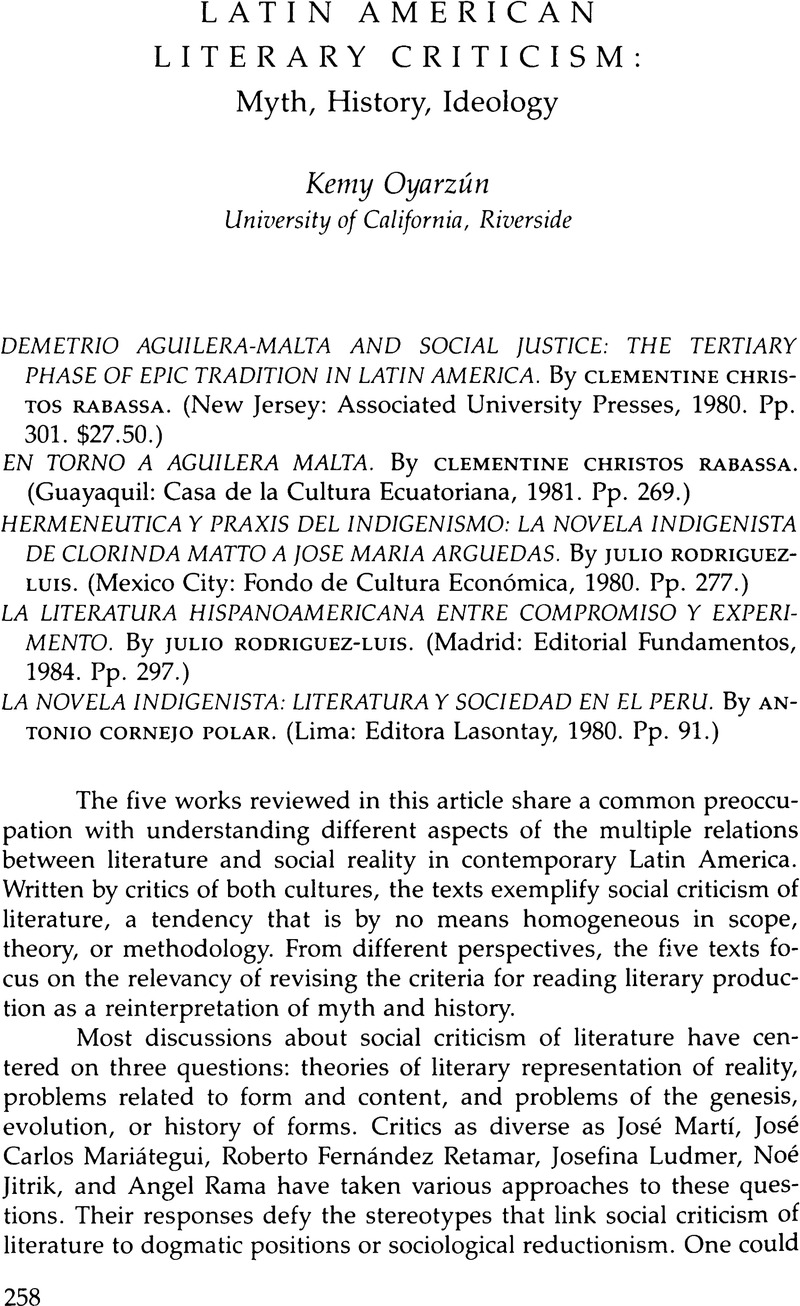No CrossRef data available.
Published online by Cambridge University Press: 12 October 2022

1. See Angel Rama, “Rodolfo Walsh: la narrativa en el conflicto de las culturas,” Literatura y clase social (Mexico City: Folios Ediciones, 1983), 195–220.
2. See Angel Rama's Transculturación narrativa en América Latina (Mexico City: Siglo Veintiuno Editores, 1982).
3. Hernán Vidal analyzes the network of ideological and market determinations in the construction of the so-called literary boom during the 1960s. See his Literatura hispanoamericana e ideología liberal (Buenos Aires: Hispamérica, 1976).
4. Several readers have pointed out this critical function of mythology in literature. See Georg Lukács, “El ideal del hombre armonioso en el capitalismo,” in Problemas del realismo (Mexico City: Fondo de Cultura Económica, 1967); Héctor Mario Cavallari, Leopoldo Marechal: el espacio de los signos (Xalapa, Mexico: Universidad Veracruzana, 1982); and Herbert Marcuse, Eros y civilización (Mexico: Siglo Veintiuno, 1976).
5. See, among others, Fernando Alegría, Nueva historia de la novela hispanoamericana (New Hampshire: Ediciones del Norte, 1986); Enrique Anderson Imbert, Historia de la literatura hispanoamericana (Mexico City: Fondo de Cultura Económica, 1957); América Latina en su literatura, edited by César Fernández Moreno (Mexico City: Siglo Veintiuno, 1969); and Jean Franco, La cultura moderna en América Latina (Mexico City: Joaquín Mortiz, 1971).
6. Rama says in this respect, “From that choice we observe an internal treatment of those forms, introducing notorious modifications [of the genre] and at the same time fortifying that operation with the support of elements from the native culture” (quoted by Cornejo Polar, 62; my translation).
7. See Gerardo Luzuriaga, Del realismo al expresionismo: el teatro de Demetrio Aguilera Malta (Madrid: Plaza Mayor, 1971), 141, quoted by Rabassa in En torno a Aguilera Malta, p. 185, n. 27.
To send this article to your Kindle, first ensure no-reply@cambridge.org is added to your Approved Personal Document E-mail List under your Personal Document Settings on the Manage Your Content and Devices page of your Amazon account. Then enter the ‘name’ part of your Kindle email address below. Find out more about sending to your Kindle. Find out more about saving to your Kindle.
Note you can select to save to either the @free.kindle.com or @kindle.com variations. ‘@free.kindle.com’ emails are free but can only be saved to your device when it is connected to wi-fi. ‘@kindle.com’ emails can be delivered even when you are not connected to wi-fi, but note that service fees apply.
Find out more about the Kindle Personal Document Service.
To save this article to your Dropbox account, please select one or more formats and confirm that you agree to abide by our usage policies. If this is the first time you used this feature, you will be asked to authorise Cambridge Core to connect with your Dropbox account. Find out more about saving content to Dropbox.
To save this article to your Google Drive account, please select one or more formats and confirm that you agree to abide by our usage policies. If this is the first time you used this feature, you will be asked to authorise Cambridge Core to connect with your Google Drive account. Find out more about saving content to Google Drive.